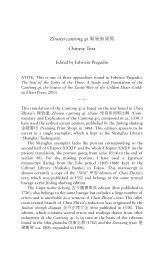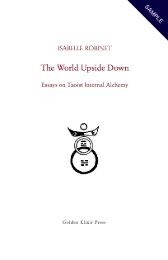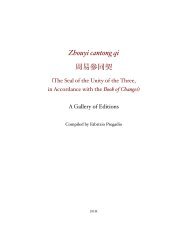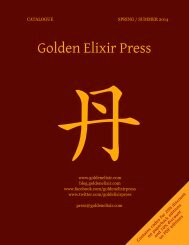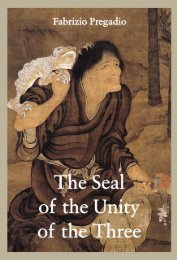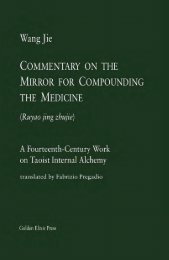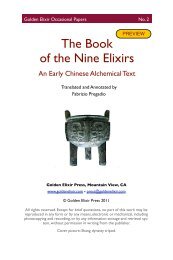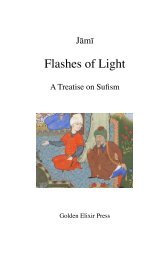The Seal of the Unity of the Three â Vol. 2 - The Golden Elixir
The Seal of the Unity of the Three â Vol. 2 - The Golden Elixir
The Seal of the Unity of the Three â Vol. 2 - The Golden Elixir
- No tags were found...
Create successful ePaper yourself
Turn your PDF publications into a flip-book with our unique Google optimized e-Paper software.
2. Song and Yuan Dynasties 139<br />
—————————————————————————————————————————<br />
capable author <strong>of</strong> <strong>the</strong> Later Han dynasty. It is never senseless, but<br />
since its language is grounded on ancient works and is beyond <strong>the</strong><br />
understanding <strong>of</strong> present-day people, it has been interpreted in<br />
senseless ways. 11<br />
<strong>The</strong> interpretation <strong>of</strong>fered in <strong>the</strong> Kaoyi is primarily cosmological.<br />
Although Zhu Xi states that <strong>the</strong> Cantong qi does not consist <strong>of</strong> an<br />
explication <strong>of</strong> <strong>the</strong> Book <strong>of</strong> Changes, but uses its emblems to describe<br />
<strong>the</strong> Neidan practice, 12 <strong>the</strong> most detailed remarks in his commentary<br />
concern passages related to cosmology, and <strong>the</strong> alchemical import <strong>of</strong><br />
<strong>the</strong> text is <strong>of</strong>ten neglected or discounted. In fact, Zhu Xi comments on<br />
about a dozen passages by saying “I do not clearly understand what<br />
this means” (wei xiang qi zhi 未 詳 其 指 ) or in analogous ways. 13 On<br />
<strong>the</strong> o<strong>the</strong>r hand, <strong>the</strong> junctures at which Zhu Xi inserts his comments<br />
are <strong>of</strong>ten more accurate than <strong>the</strong> subdivisions into sections made by<br />
Peng Xiao.<br />
<strong>The</strong> Kaoyi was first published by Cai Yuanding’s son, Cai Yuan 蔡<br />
淵 (1156–1236), in 1198, shorty after its completion. 14 Later, in <strong>the</strong><br />
first half <strong>of</strong> <strong>the</strong> fourteenth century, it was edited by Huang Ruijie 黃 瑞<br />
節 (fl. 1341), who included it in his Zhuzi chengshu 朱 子 成 書 , an<br />
early collection <strong>of</strong> Zhu Xi’s works. Huang added an undated preface,<br />
as well as notes consisting <strong>of</strong> his own comments and <strong>of</strong> quotations<br />
from o<strong>the</strong>r works by Zhu Xi. In addition to <strong>the</strong> Kaoyi, Huang knew<br />
Peng Xiao’s commentary in <strong>the</strong> reedition by Bao Huanzhi, whom he<br />
quotes in his preface and in a note attached to Zhu Xi’s commentary. 15<br />
In clear contrast with its title, and with Zhu Xi’s own statements<br />
about his philological work found in both <strong>the</strong> preface and <strong>the</strong><br />
postface, <strong>the</strong> commentary contains only a handful <strong>of</strong> critical notes. In<br />
o<strong>the</strong>r works, moreover, Zhu Xi points out variants and suggests<br />
11<br />
Zhuzi yulei, 125.3002; also quoted by Huang Ruijie in Zhouyi cantong<br />
qi [kaoyi], preface, 2b-3a.<br />
12<br />
Zhouyi cantong qi [kaoyi], preface, 2a.<br />
13<br />
Zhouyi cantong qi [kaoyi], 1.3b, 1.11b, 1.14b, 1.16a, 1.18a, 2.8b, 2.10a,<br />
2.11a, 3.2a, 3.4a, and 3.5b. On this point see Azuma, “Shu Ki Shūeki sandōkei<br />
kōi ni tsuite,” p. 181, who provides a detailed analysis <strong>of</strong> <strong>the</strong> commentary on<br />
pp. 181–86; and Kim Yung Sik, “<strong>The</strong> Ts’an-t’ung-ch’i k’ao-i”, pp. 121–22.<br />
14<br />
See Lin Zhenli, “Zhu Xi: Zuowei bianji chubanjia de pingjie”, 181.<br />
15<br />
Zhouyi cantong qi [kaoyi], preface, 1b, and 1.5a, respectively.<br />
Visit <strong>the</strong> Web page on this book • www.goldenelixir.com



